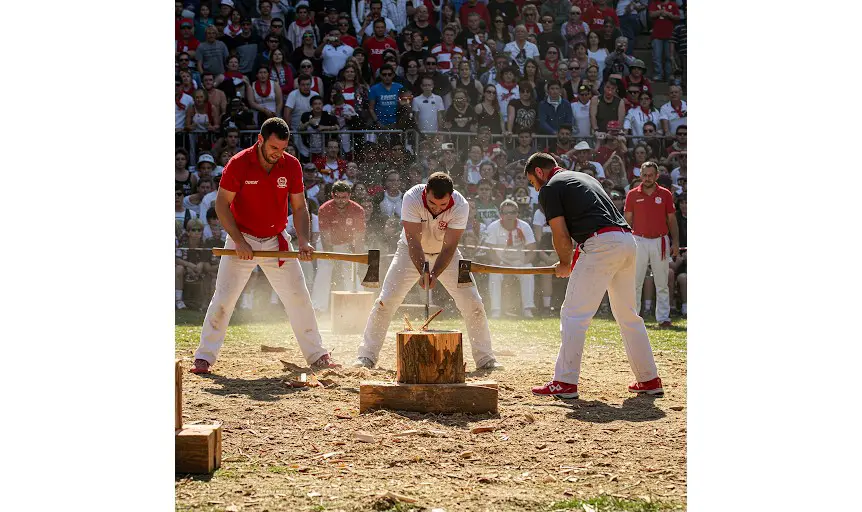
Aizkolaritza: The Timeless Art of Basque Wood-Chopping
Aizkolaritza is more than a sport. It represents heritage, tradition, and sheer physical prowess. Originating in the Basque Country, this wood-chopping competition has captured the hearts of spectators for centuries. From rugged mountain villages to modern-day arenas, Aizkolaritza continues to thrive. The sport’s growth has sparked interest far beyond its native roots. Today, people around the globe recognize Aizkolaritza as a symbol of Basque identity. Let’s explore this fascinating sport’s origin, global reach, amateur involvement, professional structure, cultural significance, and detailed rules.
Origins and History of Aizkolaritza
The history of Aizkolaritza dates back to ancient forestry practices in the Basque Country. Originally, Basque lumberjacks chopped wood for survival. Their work provided essential resources like firewood, shelter, and tools. Eventually, these tasks transformed into challenges of skill and strength. Villagers would compete informally to prove who could chop wood the fastest.
By the 19th century, these contests became organized events. Local festivals often included wood-chopping as a central attraction. Competitors used traditional axes and competed on large logs. These early Aizkolaris (wood-choppers) were revered figures in their communities. Strength and stamina defined their fame. As competitions grew, so did the respect for their athletic abilities.
Aizkolaritza soon gained attention beyond rural villages. Urban centers embraced the sport during regional fairs and exhibitions. The establishment of formal competitions solidified its status as a respected athletic pursuit. The early 20th century marked a turning point. At that time, the first official tournaments were documented. Photographs and press coverage helped spread the sport’s popularity across Spain.
Global Popularity of Aizkolaritza
Although deeply rooted in Basque culture, Aizkolaritza has inspired audiences globally. The Basque diaspora played a key role in this spread. Many Basque families settled in countries such as the United States, Argentina, Chile, and Australia. These communities preserved their traditions, including Aizkolaritza.
Cultural centers abroad began hosting local competitions. These events attracted both Basques and non-Basques alike. In Argentina, festivals often feature wood-chopping as a highlight. In the United States, particularly in Idaho and Nevada, Basque festivals include Aizkolaritza demonstrations. These exhibitions aim to educate and entertain while preserving heritage.
International interest has also grown through media. Documentaries, social media, and YouTube have brought the sport to a wider audience. Moreover, travel shows featuring the Basque Country often highlight local traditions. Aizkolaritza stands out as one of the most visually captivating.
While it hasn’t reached the status of Olympic sports, its niche popularity continues to rise. Enthusiasts in other wood sports, such as timbersports athletes, often draw inspiration from Aizkolaritza. The sport’s authenticity appeals to those seeking a raw, unfiltered athletic experience.
Amateur Aizkolaritza: Grassroots to Youth Programs
Amateur Aizkolaritza thrives at the grassroots level. Local clubs and associations play a pivotal role in maintaining interest. These clubs organize training sessions, community events, and friendly competitions.
In the Basque Country, many villages still host regular events. Families often encourage children to participate. Youth programs introduce the basics in a safe and supportive setting. Smaller, lighter logs are used for young participants. Safety equipment is standard. These programs emphasize proper technique over brute strength.
Schools in the Basque region also include traditional sports in physical education. Aizkolaritza shares the spotlight with other rural activities such as stone lifting and hay bale tossing. Students gain both cultural knowledge and physical skills.
Workshops and summer camps offer another avenue for young athletes. Instructors, often experienced competitors, teach techniques and wood-handling skills. Youth tournaments foster friendly rivalry and community bonding. These events ensure that Aizkolaritza remains accessible to the next generation.
Outside of the Basque Country, amateur Aizkolaritza also exists. Basque cultural organizations abroad provide similar opportunities. Weekend classes and seasonal events attract enthusiasts of all ages. These groups ensure that the tradition continues even in distant lands.
Professional Leagues and Competitions
Professional Aizkolaritza boasts a well-organized structure. The Basque Country hosts the majority of major tournaments. Athletes train year-round for events such as the Urrezko Aizkora (Golden Axe) and the Euskal Herriko Txapelketa (Basque Country Championship).
Competitions are intense and require tremendous endurance. Athletes chop through several logs in timed formats. Categories vary based on log size and weight. The most prestigious tournaments include qualification rounds, semi-finals, and finals.
Television networks often broadcast these events. Commentators provide expert analysis, and fans closely follow their favorite Aizkolaris. Sponsorship deals and endorsements have also emerged. While not as lucrative as mainstream sports, the financial support helps athletes dedicate themselves fully.
In Spain, the Federation of Rural Sports oversees regulation. It ensures fair play and safety. Equipment standards, log dimensions, and scoring systems are strictly maintained. Outside Spain, smaller leagues exist, particularly in Latin America. Though less formal, these leagues keep the competitive spirit alive.
The creation of international exhibition matches has added excitement. Competitors from different countries face off in friendly yet fierce battles. These matches highlight the global reach of the sport. They also promote cultural exchange.
Political and Social Significance
Aizkolaritza holds profound cultural meaning. It symbolizes Basque identity, resilience, and unity. Through this sport, the Basque people express pride in their language, history, and traditions.
During the Franco regime in Spain, Basque cultural expressions were suppressed. Despite this, Aizkolaritza survived. It became a quiet act of resistance. Public competitions were reduced, but local gatherings continued. These events fostered solidarity among Basques.
Today, Aizkolaritza serves as a cultural bridge. It connects generations, rural and urban communities, and Basques at home and abroad. Participation brings people together. Festivals featuring Aizkolaritza strengthen local economies and attract tourists.
The sport also challenges traditional gender roles. While historically male-dominated, more women now participate. Female Aizkolaris receive increasing recognition. Their inclusion promotes gender equality and inspires young girls.
Environmental awareness has also entered the scene. Sustainable forestry practices are now emphasized. Events use locally sourced logs and promote reforestation. This responsible approach aligns with global ecological goals.
Through symbolism, social impact, and cultural pride, Aizkolaritza continues to shape the Basque experience. Its influence reaches into education, politics, and even international diplomacy.
Rules and Format of Aizkolaritza
Aizkolaritza follows specific rules to ensure fairness and safety. Each competitor, or Aizkolari, faces off against one or more opponents. The objective is simple: chop through a predetermined number of logs as quickly as possible.
Logs vary by event category. Common sizes include 45 cm and 54 cm in diameter. Some advanced competitions use logs over 60 cm. Each log is placed on a wooden cradle. This keeps it steady and allows clean strikes.
Competitors use traditional Basque axes. These tools are sharp, heavy, and carefully maintained. Before the event, the logs are inspected. Any imperfections must be reported and replaced.
Athletes wear specific gear for safety and performance. Protective boots, gloves, and leg guards are standard. Each round begins with a countdown. Judges and timekeepers oversee the event.
The competitor starts chopping from the top. They must alternate sides for efficiency. Technique matters as much as strength. Incorrect swings waste time and energy.
Judging criteria include speed, technique, and completeness. A log must be fully severed to count. Ties result in additional chopping rounds. Events may include individual and team formats.
Training is rigorous. Aizkolaris spend years perfecting form and building endurance. Mental focus is essential. One mistake can cost the match.
Conclusion
Aizkolaritza is a living testament to Basque culture and resilience. From humble forest roots to international stages, it has evolved with purpose. The sport’s appeal lies in its raw authenticity, cultural depth, and visual drama. With growing amateur programs and professional leagues, Aizkolaritza continues to inspire.
The sport’s political, social, and environmental significance further enriches its legacy. Through well-defined rules and deep tradition, it captivates audiences young and old. As the world grows more connected, this age-old competition stands as a proud emblem of identity and passion.
For those seeking a blend of history, culture, and sport, Aizkolaritza delivers. Whether in a village square or a televised arena, the sound of axes meeting wood continues to echo. That sound tells a story—a story of strength, tradition, and unity.





